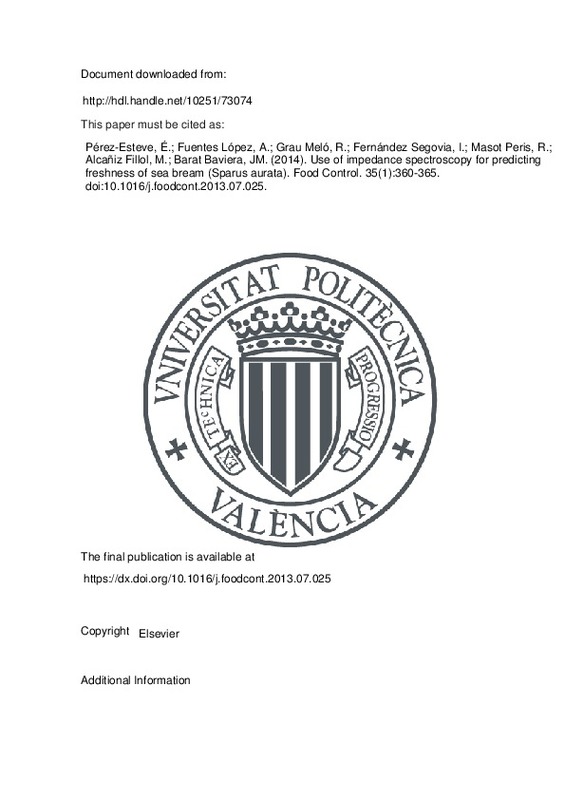JavaScript is disabled for your browser. Some features of this site may not work without it.
Buscar en RiuNet
Listar
Mi cuenta
Estadísticas
Ayuda RiuNet
Admin. UPV
Use of impedance spectroscopy for predicting freshness of sea bream (Sparus aurata)
Mostrar el registro sencillo del ítem
Ficheros en el ítem
| dc.contributor.author | Pérez-Esteve, Édgar
|
es_ES |
| dc.contributor.author | Fuentes López, Ana
|
es_ES |
| dc.contributor.author | Grau Meló, Raúl
|
es_ES |
| dc.contributor.author | Fernández Segovia, Isabel
|
es_ES |
| dc.contributor.author | Masot Peris, Rafael
|
es_ES |
| dc.contributor.author | Alcañiz Fillol, Miguel
|
es_ES |
| dc.contributor.author | Barat Baviera, José Manuel
|
es_ES |
| dc.date.accessioned | 2016-11-02T08:21:43Z | |
| dc.date.available | 2016-11-02T08:21:43Z | |
| dc.date.issued | 2014-01 | |
| dc.identifier.issn | 0956-7135 | |
| dc.identifier.uri | http://hdl.handle.net/10251/73074 | |
| dc.description.abstract | In the present study, the use of a rapid portable system based on impedance spectroscopy to assess fish freshness has been tested. The evolution of different physical and chemical parameters (moisture, fat, pH and TVBN) and impedance measurements (modulus and phase at different frequencies) of six different batches of sea bream (Sparus aurata) were analysed. Impedance spectroscopy was able to classify raw matter into six groups according to composition differences, and also to classify those samples stored for a time of between 0 and 15 days into different groups according to degree of freshness. TVB-N is one of the most usual parameters to assess shelf life periods of fish samples; the coefficient of determination (R2) of 0.72 obtained in the Partial Least Squares regression for this parameter confirmed the potential application of the impedance spectroscopy for predicting sea bream freshness | es_ES |
| dc.description.sponsorship | The authors gratefully acknowledge financial support from the Spanish Government (Project AGL2010-20539). E.P. is grateful to the Spanish Ministry of Science and Innovation for his grant (AP2008-00620). | en_EN |
| dc.language | Inglés | es_ES |
| dc.publisher | Elsevier | es_ES |
| dc.relation.ispartof | Food Control | es_ES |
| dc.rights | Reserva de todos los derechos | es_ES |
| dc.subject | Sea bream | es_ES |
| dc.subject | Freshness | es_ES |
| dc.subject | Impedance spectroscopy | es_ES |
| dc.subject | Non-destructive sensor | es_ES |
| dc.subject | PLS regression | es_ES |
| dc.subject | Linear discriminant analysis | es_ES |
| dc.subject.classification | TECNOLOGIA DE ALIMENTOS | es_ES |
| dc.subject.classification | TECNOLOGIA ELECTRONICA | es_ES |
| dc.title | Use of impedance spectroscopy for predicting freshness of sea bream (Sparus aurata) | es_ES |
| dc.type | Artículo | es_ES |
| dc.identifier.doi | 10.1016/j.foodcont.2013.07.025 | |
| dc.relation.projectID | info:eu-repo/grantAgreement/MICINN//AGL2010-20539/ES/DESARROLLO DE SENSORES ELECTRONICOS Y FOTONICOS PARA EL ANALISIS Y CONTROL DE PRODUCTOS Y PROCESOS CARNICOS Y DE LA PESCA/ | es_ES |
| dc.relation.projectID | info:eu-repo/grantAgreement/MICINN//AP2008-00620/ES/AP2008-00620/ / | es_ES |
| dc.rights.accessRights | Abierto | es_ES |
| dc.contributor.affiliation | Universitat Politècnica de València. Departamento de Tecnología de Alimentos - Departament de Tecnologia d'Aliments | es_ES |
| dc.contributor.affiliation | Universitat Politècnica de València. Departamento de Ingeniería Electrónica - Departament d'Enginyeria Electrònica | es_ES |
| dc.description.bibliographicCitation | Pérez-Esteve, É.; Fuentes López, A.; Grau Meló, R.; Fernández Segovia, I.; Masot Peris, R.; Alcañiz Fillol, M.; Barat Baviera, JM. (2014). Use of impedance spectroscopy for predicting freshness of sea bream (Sparus aurata). Food Control. 35(1):360-365. https://doi.org/10.1016/j.foodcont.2013.07.025 | es_ES |
| dc.description.accrualMethod | S | es_ES |
| dc.relation.publisherversion | https://dx.doi.org/10.1016/j.foodcont.2013.07.025 | es_ES |
| dc.description.upvformatpinicio | 360 | es_ES |
| dc.description.upvformatpfin | 365 | es_ES |
| dc.type.version | info:eu-repo/semantics/publishedVersion | es_ES |
| dc.description.volume | 35 | es_ES |
| dc.description.issue | 1 | es_ES |
| dc.relation.senia | 248505 | es_ES |
| dc.identifier.eissn | 1873-7129 |







![[Cerrado]](/themes/UPV/images/candado.png)

